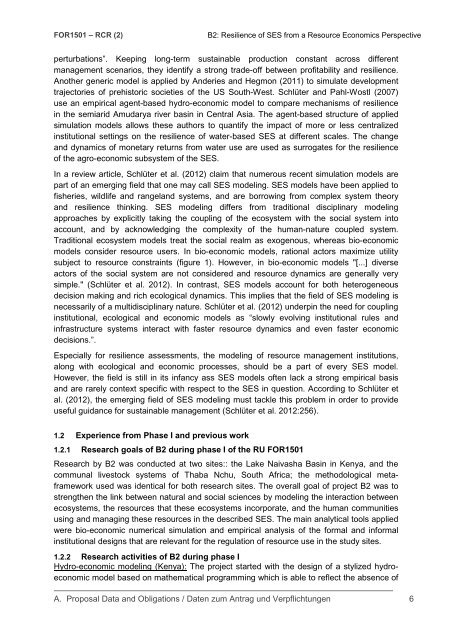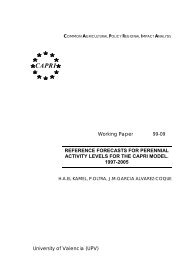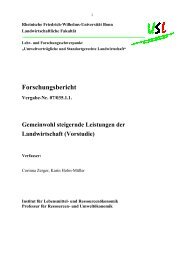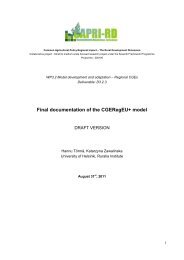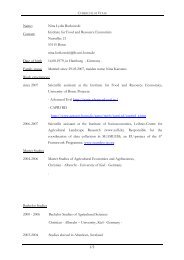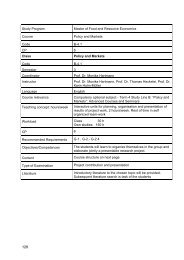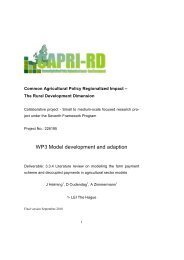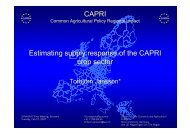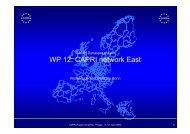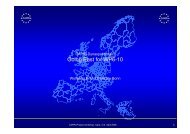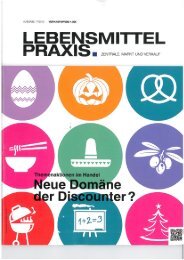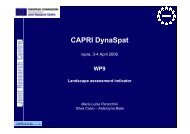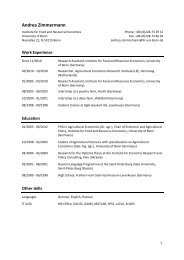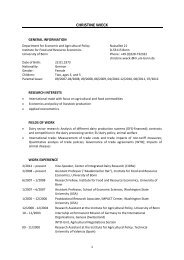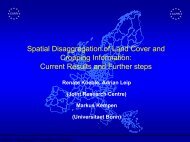Research proposal of sub-project B2 for second phase - Institut für ...
Research proposal of sub-project B2 for second phase - Institut für ...
Research proposal of sub-project B2 for second phase - Institut für ...
Create successful ePaper yourself
Turn your PDF publications into a flip-book with our unique Google optimized e-Paper software.
FOR1501 – RCR (2)<br />
<strong>B2</strong>: Resilience <strong>of</strong> SES from a Resource Economics Perspective<br />
perturbations”. Keeping long-term sustainable production constant across different<br />
management scenarios, they identify a strong trade-<strong>of</strong>f between pr<strong>of</strong>itability and resilience.<br />
Another generic model is applied by Anderies and Hegmon (2011) to simulate development<br />
trajectories <strong>of</strong> prehistoric societies <strong>of</strong> the US South-West. Schlüter and Pahl-Wostl (2007)<br />
use an empirical agent-based hydro-economic model to compare mechanisms <strong>of</strong> resilience<br />
in the semiarid Amudarya river basin in Central Asia. The agent-based structure <strong>of</strong> applied<br />
simulation models allows these authors to quantify the impact <strong>of</strong> more or less centralized<br />
institutional settings on the resilience <strong>of</strong> water-based SES at different scales. The change<br />
and dynamics <strong>of</strong> monetary returns from water use are used as surrogates <strong>for</strong> the resilience<br />
<strong>of</strong> the agro-economic <strong>sub</strong>system <strong>of</strong> the SES.<br />
In a review article, Schlüter et al. (2012) claim that numerous recent simulation models are<br />
part <strong>of</strong> an emerging field that one may call SES modeling. SES models have been applied to<br />
fisheries, wildlife and rangeland systems, and are borrowing from complex system theory<br />
and resilience thinking. SES modeling differs from traditional disciplinary modeling<br />
approaches by explicitly taking the coupling <strong>of</strong> the ecosystem with the social system into<br />
account, and by acknowledging the complexity <strong>of</strong> the human-nature coupled system.<br />
Traditional ecosystem models treat the social realm as exogenous, whereas bio-economic<br />
models consider resource users. In bio-economic models, rational actors maximize utility<br />
<strong>sub</strong>ject to resource constraints (figure 1). However, in bio-economic models "[...] diverse<br />
actors <strong>of</strong> the social system are not considered and resource dynamics are generally very<br />
simple." (Schlüter et al. 2012). In contrast, SES models account <strong>for</strong> both heterogeneous<br />
decision making and rich ecological dynamics. This implies that the field <strong>of</strong> SES modeling is<br />
necessarily <strong>of</strong> a multidisciplinary nature. Schlüter et al. (2012) underpin the need <strong>for</strong> coupling<br />
institutional, ecological and economic models as “slowly evolving institutional rules and<br />
infrastructure systems interact with faster resource dynamics and even faster economic<br />
decisions.”.<br />
Especially <strong>for</strong> resilience assessments, the modeling <strong>of</strong> resource management institutions,<br />
along with ecological and economic processes, should be a part <strong>of</strong> every SES model.<br />
However, the field is still in its infancy ass SES models <strong>of</strong>ten lack a strong empirical basis<br />
and are rarely context specific with respect to the SES in question. According to Schlüter et<br />
al. (2012), the emerging field <strong>of</strong> SES modeling must tackle this problem in order to provide<br />
useful guidance <strong>for</strong> sustainable management (Schlüter et al. 2012:256).<br />
1.2 Experience from Phase I and previous work<br />
1.2.1 <strong>Research</strong> goals <strong>of</strong> <strong>B2</strong> during <strong>phase</strong> I <strong>of</strong> the RU FOR1501<br />
<strong>Research</strong> by <strong>B2</strong> was conducted at two sites:: the Lake Naivasha Basin in Kenya, and the<br />
communal livestock systems <strong>of</strong> Thaba Nchu, South Africa; the methodological metaframework<br />
used was identical <strong>for</strong> both research sites. The overall goal <strong>of</strong> <strong>project</strong> <strong>B2</strong> was to<br />
strengthen the link between natural and social sciences by modeling the interaction between<br />
ecosystems, the resources that these ecosystems incorporate, and the human communities<br />
using and managing these resources in the described SES. The main analytical tools applied<br />
were bio-economic numerical simulation and empirical analysis <strong>of</strong> the <strong>for</strong>mal and in<strong>for</strong>mal<br />
institutional designs that are relevant <strong>for</strong> the regulation <strong>of</strong> resource use in the study sites.<br />
1.2.2 <strong>Research</strong> activities <strong>of</strong> <strong>B2</strong> during <strong>phase</strong> I<br />
Hydro-economic modeling (Kenya): The <strong>project</strong> started with the design <strong>of</strong> a stylized hydroeconomic<br />
model based on mathematical programming which is able to reflect the absence <strong>of</strong><br />
A. Proposal Data and Obligations / Daten zum Antrag und Verpflichtungen 6


